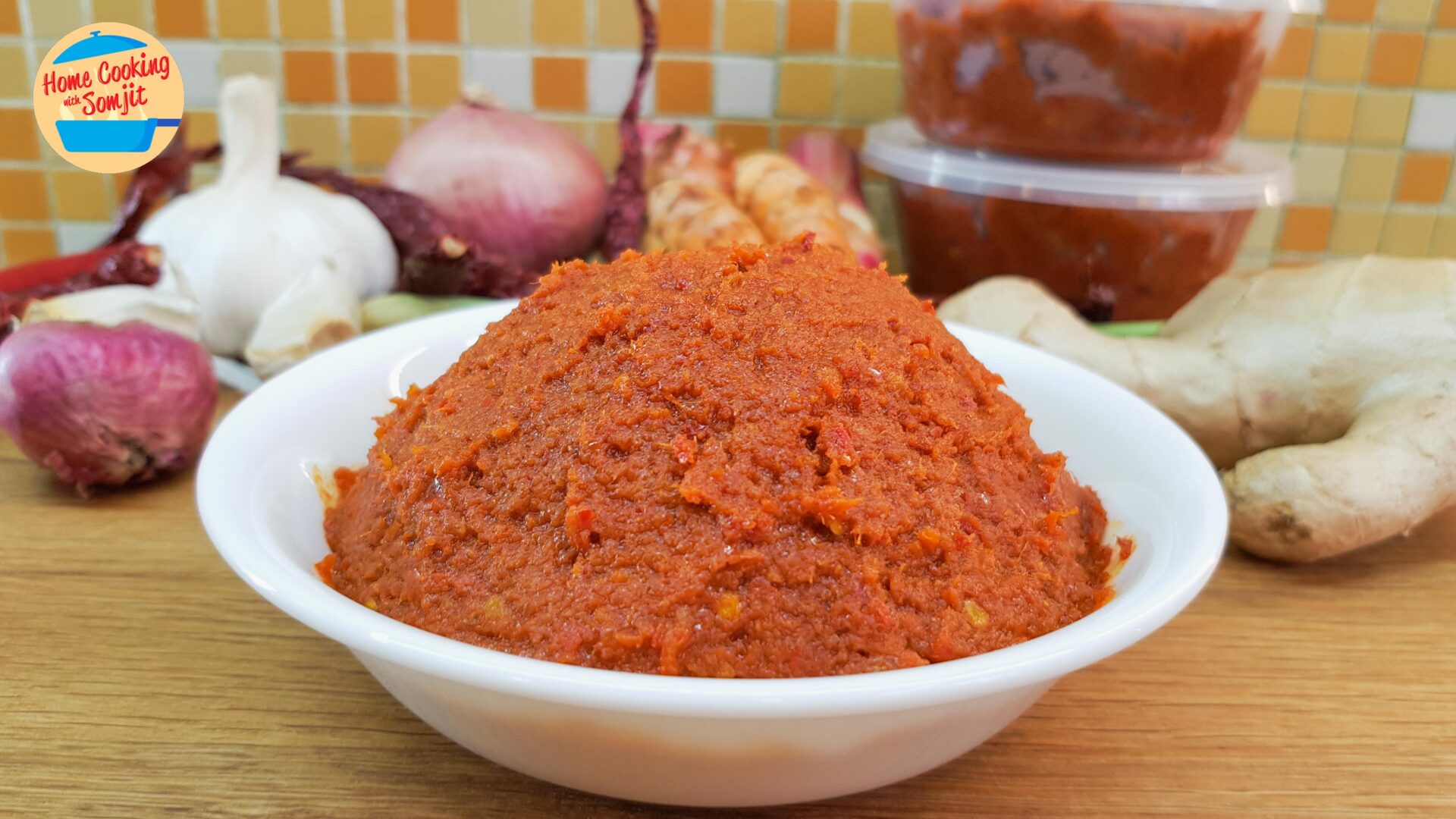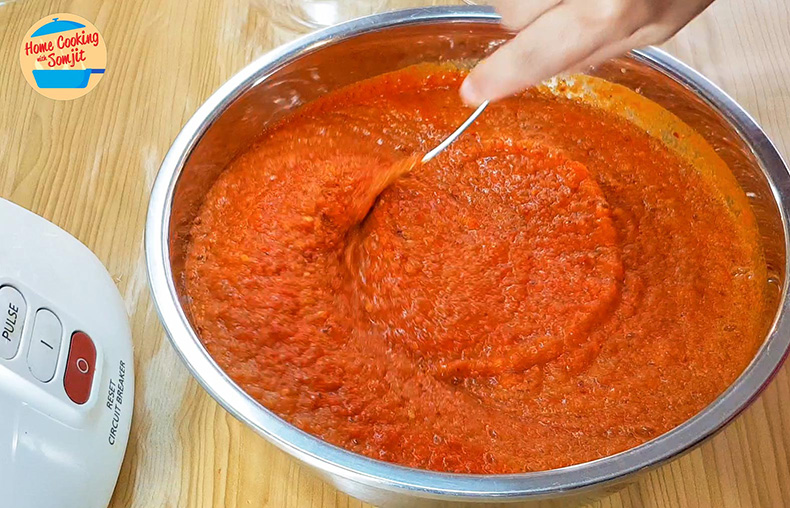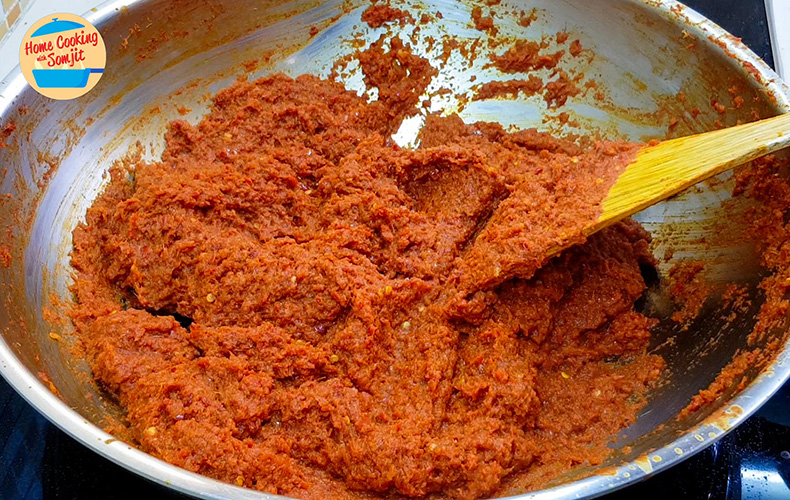Making 1kg of Sambal Paste

Sambal Paste is a staple ingredient used by many Malaysian households. It is slightly sour, spicy, and has a really deliciously rich and deep umami flavour. Add sambal into any vegetable or meat dish to get an easy stir fry meal to enjoy with rice, such as Sambal Long Beans.
Though sambal paste is available in stores, I’ve found that making my own from scratch enables me to directly control the spiciness, saltiness, and sourness of the sambal. The only downside is it takes a good amount of effort and time to make for individual dishes.
So here is a recipe that prepares 1 kilogramme of sambal paste in advance. It takes roughly 2-3 hours to make, but it saves a lot of time when using a small portion to cook.
Sambal Paste Recipe
Ingredients
The main ingredients for a good sambal paste are fresh red chillis, dried chillis, and herbs. The fresher the herbs, the more potent the fragrance and taste the paste will be. Dried chillis give the vibrant red colour and spiciness.
Specifically, I use a type of chilli called “cili besar”, or “guajillo chillies”. They are not very spicy, with the natural chilli flavour being more prominent in taste. Use more of these chillies for a less spicy sambal paste. The dried chillies, fresh chilli and ginger give heat to the paste.

As for the herbs, lemongrass, ginger, turmeric impart their fragrance to the sambal paste. Red onions, garlic and shallots are also aromatic herbs used, and they also lend their sweetness to the paste. Shrimp paste (belacan) and dried shrimp bring an umami flavour profile, while candlenuts make it creamy. Lastly, I used tamarind water for its mildly tangy flavours, and the seasonings of salt and sugar are to taste. Water and some cooking oil are used as well to make it easier to blend the ingredients and cook the sambal paste.

Just to note, the shrimp paste I used is from Thailand, and it has a mildly salty flavour. If using a salty type of shrimp paste, be sure to reduce the amount of salt. I’ve made this recipe milder in saltiness so that it can be adjusted later on when used to cook vegetables and meat.
Preparing the Sambal Paste
All of the ingredients prepared need to be blended until very fine and smooth. So, to prepare for ease of blending, chop all these ingredients into smaller pieces:
- ginger
- young galangal
- lemongrass (sliced thinly as they are very fibrous)
- red chilli
- red onions
- large shallots
- turmeric, with the skin on to prevent staining the chopping board
Candlenuts and small shallots can be blended whole. Then blend all the ingredients together if possible.
As my own blender is too small for this amount of ingredients, I have to blend them in stages. I started with ginger, young galangal, candlenuts, turmeric, lemongrass, dried shrimps and shrimp paste (belacan). I also added 150ml of water before blending it for about 1 minute.
After 1 minute, I added in 100ml of water as I found the paste mixture was too dry to blend properly. Continue blending for 20 seconds, or until the paste mixture is very fine.

Then, add in the garlic and red chilli. Blend for another 45 seconds, or until the red chilli and garlic are fully incorporated. As there’s more room in the blender, add in both the chilli paste and 150ml of water. Blend the paste mixture for 30 seconds, or until well-combined.
Once all the ingredients are blended, empty the paste mixture into a large mixing bowl. Now we will blend the rest of the ingredients.
Blend all the shallots, onions, and 200ml of water for about 40 seconds, or until very fine and smooth. When it’s done, pour the blended shallots and onions into the mixing bowl with the paste mixture.

Add in the sugar, salt and tamarind water, stirring until the seasonings have been incorporated. Then, it’s time to cook the sambal paste.
Cooking Sambal Paste
Heat a stainless steel pan over medium heat and add in all the cooking oil. While the oil is still cool, pour in all of the sambal paste. This is to prevent the oil from splattering as hot oil and moisture often result in a very large oil splash, which would be quite dangerous.

Now is the fun part with the most effort: stirring the sambal paste in oil for an hour. Within 3 minutes, it comes to a boil with tiny bubbles expanding and popping on the surface. It is important to continuously stir as lots of bubbles can come up to the surface and result in frequent splattering that can be painful.
Stir at moderate speed in one direction, either clockwise or anti-clockwise to evenly distribute the heat and to break up the tiny bubbles before they reach the surface. As time goes on, a lot of moisture from the paste will evaporate, reducing its volume and thickening its consistency.

Personally, at this stage, I would settle comfortably at the stove with some YouTube videos on autoplay (with lots of interesting Thai drama to watch) as I continuously stir the sambal paste. Ensure that the timer for an hour is set, and keep an eye on it.
After an hour has passed, the sambal paste’s volume has reduced to 1/3 of its original amount and its consistency is of a thick paste. Switch off the heat, leaving it in the pan to cool.

A portion of the sambal paste can be used immediately for a recipe if desired.
Storing Sambal Paste
Once fully cooled for about 2 hours, distribute the sambal paste into smaller portions. Store in clean, airtight containers. They can last about 2-3 weeks in the fridge, and in the freezer for about 3 months.

I recorded down the weight as well as the date made for each container for ease of reference in the future.
That’s all! The sambal paste does take up quite an effort, but it’s worth it with the cooking time saved when making sambal dishes. In addition, they are freshly made with ingredients you know and customizable according to your taste preference. Enjoy!

1 Kilogram of Sambal Recipe for Advance Prep
Equipment
- Blender/ Food Processor
- Frying Pan
- Silicone Spatula
- Stainless basin
Ingredients
- 5 pieces red chilli, fresh
- 60 g lemongrass, sliced thinly
- 250 g red onions, washed & chopped
- 75 g garlic, peeled & washed
- 250 g shallots, peeled & washed
- 2 tbsp shrimp paste
- 1.5 tbsp dried shrimps, washed & soaked in hot water for 1 minute
- 1 tsp salt
- 30 g ginger, peeled & chopped
- 35 g young galangal, peeled & chopped
- 20 g turmeric, chopped
- 6 pieces candlenuts
- 175 g blended guajillo chilli
- 150 g blended dried chilli
- 600 ml water
- 1/2 cup tamarind water, diluted
- 1.5 tbsp sugar
- 5 tbsp cooking oil, unscented
Instructions
Preparing Ingredients
- Chop the ginger, young galangal, turmeric (leave unpeeled), and lemongrass into smaller pieces.
- Slice the lemongrass thinly.
- Peel and wash the garlic, shallots and red onions. Chop the red chillies.
- Soak the dried shrimp in hot water for 1 minute. Drain the water.
Blending
- Blend the pieces of ginger, young galangal, candlenuts, turmeric, lemongrass, dried shrimps, shrimp paste, and 100ml of water for 1 minute, or until very fine. Empty into a large mixing bowl.
- Blend the garlic, red chilli, both the chilli pastes, and 150ml of water for 30 seconds or until very fine. Empty into the large mixing bowl.
- Blend the shallots, onions, and 200ml of water for 40 seconds or until very fine and smooth. Empty into the large mixing bowl.
- Stir the blended sambal mixture until well-combined.
Cooking the Sambal Paste
- Heat a stainless steel pan over medium heat. Pour the cooking oil into the pan.
- While the oil is still cool, add in all the blended sambal mixture.
- Continuously stir in one direction for about 1 hour, or until the sambal mixture's volume has reduced to 1/3 of its amount, and has thickened to a paste-like consistency.
- Switch off the heat, and allow the sambal paste to cool in the pan.
- Once cooled, portion the sambal into clean, air-tight containers. Label the containers and store them.
Video
Notes
Storage Instructions:
- Keeps for 2-3 weeks in the fridge.
- Keeps for up to 3 months frozen in the freezer.